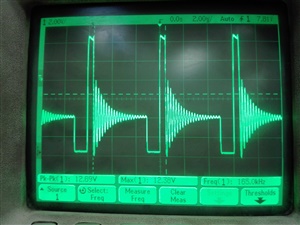Other Parts Discussed in Thread: PTN78000A,
Hi,
We built a custom circuit containing the TPS61088 IC and the PTN78000A module. My test setup is as follows:
3.7V from Bench power supply is input to TPS61088 which is used to boost it to +12V. Then this +12V is input to PTN78000A which is used to generate -12V.
Test results:
1. Testing the TPS61088 alone using a +3.7V input from the bench power supply with no load was successful. Then we started adding resistive loads of 300, 250, 200 and 150 Ohms individually and it outputs the required current and voltage drawing 306mA at 150 ohms from the +3.7V with no issues.
2. Testing the PTN78000A alone using a +12V input from the bench power supply with no load was successful drawing 39mA.
3. Testing both TPS61088 and PTN78000A connected in series (TPS is loaded by PTN) as described in the test setup above was unsuccessful. The bench power supply has a current limit set to 1A, when we power it on it immediately disconnects indicating that there is something wrong in the circuit. We found that the "SW" pins of the TPS61088 are all shorted to GND! We made this test 4 times suspecting the inductor and other passives and unfortunately lost 4 ICs in the process and still can't figure out what the issue is.
** ADDED 16/4/2017
We are suspecting the 220uF at the input of the PTN78000A is causing a high in-rush current that burn the TPS61088. To test this assumption we did the following:
- Connected a new TPS61088 IC.
- Removed the PTN module from circuit
- Tested TPS without the 220 µF capacitor. The TPS booster worked fine (it is loaded with 47 µF capacitor of its own).
- Added resistor (22 Ohms) in series with the 220 µF capacitor to limit in-rush currents. The TPS booster burned out again (short at inductor input pins again).
Below is the schematic of the TPS61088 and PTN78000A:
Regards.



